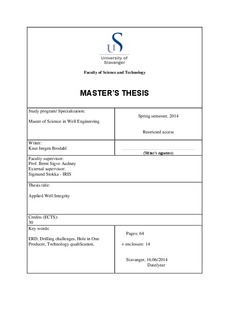| dc.contributor.author | Brodahl, Knut Jørgen | |
| dc.date.accessioned | 2014-12-17T13:02:46Z | |
| dc.date.available | 2014-12-17T13:02:46Z | |
| dc.date.issued | 2014-06-16 | |
| dc.identifier.uri | http://hdl.handle.net/11250/227640 | |
| dc.description | Master's thesis in Petroleum engineering | nb_NO |
| dc.description.abstract | Extended reach drilling is the result of industry focus to exploit fields efficiently with a minimum financial and environmental impact. Two of the ERD pioneer fields are Wytch Farm in UK and Statfjord on the Norwegian Continental Shelf. These two fields have contributed largely to the development and evolution of ERD technology and methods. ERD technology have been used to increase the drainage radius for platforms, which resulted in fewer offshore platforms in the development and a large cost saving.
Throughout the three last decades, technology have been rapidly improved towards what seems to be the limit of the conventional drilling method and technology in terms of the wells reach. The first well to break the 10 km mark was M11 at Wytch Farm in 1997. In 2013, the Z-42 was drilled on the Sakhalin Project and is with its horizontal reach of 11.7 km the world’s longest ERD well. This shows that the evolution of technology and methods have not contributed largely in increasing the maximum reach over the last decade, but the reliability and cost of equipment and operation have been greatly improved.
Limiters in ERD are elaborated in this thesis along with simple examples used to illustrate the different challenges associated with the limiting factor. Two different available technologies that can reduce impact from limiting factors are presented to show that it is possible to increase drilling efficiency with only adding one new tool.
The Hole in One Producer concept presents a new method of drilling and completing ERD wells and is thought to have a potential reach of 20 km. The concept is still in the conceptual stage and some of the technical and operational challenges are presented along with the technology qualification phase. The success of this concept is dependent on developing new technology and is therefore associated with a large financial and operational risk.
A cost comparison of the HOP concept and a subsea development shows that the HOP is approximately three times as expensive as the subsea solution. Subsea solutions is a regular operation on the NCS and are not associated with large financial risk, this is a challenge for the commercialization of the HOP concept. Identified potential areas for the HOP concept are environmental sensitive areas where conventional technology is not applicable and the use of HOP traction unit to deploy completion and pulling objects from the well. | nb_NO |
| dc.language.iso | eng | nb_NO |
| dc.publisher | University of Stavanger, Norway | nb_NO |
| dc.relation.ispartofseries | Masteroppgave/UIS-TN-IPT/2014; | |
| dc.rights | Attribution 3.0 Norway | * |
| dc.rights.uri | http://creativecommons.org/licenses/by/3.0/no/ | * |
| dc.subject | petroleumsteknologi | nb_NO |
| dc.subject | boreteknologi | nb_NO |
| dc.subject | drilling challenges | nb_NO |
| dc.subject | hole in one producer | nb_NO |
| dc.subject | technology qualification | nb_NO |
| dc.subject | ERD | nb_NO |
| dc.title | Applied well integrity | nb_NO |
| dc.type | Master thesis | nb_NO |
| dc.subject.nsi | VDP::Technology: 500::Rock and petroleum disciplines: 510::Petroleum engineering: 512 | nb_NO |
| dc.source.pagenumber | 78 | nb_NO |

